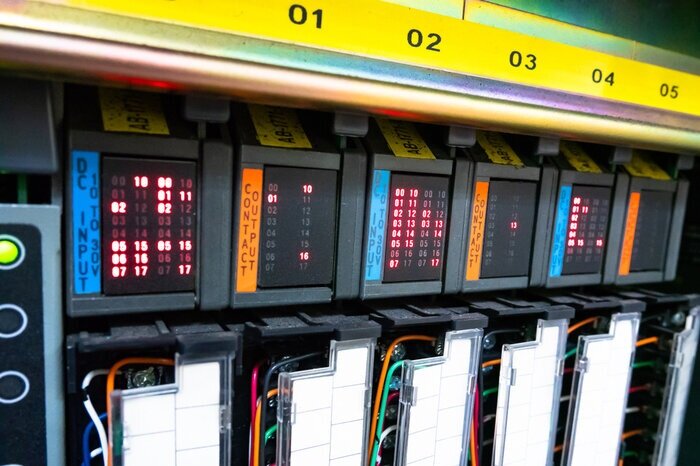The Difference Between PLC Migration and Upgrading: Finding the Right Choice for You
6 min read
You’ve got a problem. You have an old PLC, such as the Allen-Bradley PLC-5, that’s served you well for years, but now it’s no longer supported. This means that the original equipment manufacturer (OEM) is no longer offering maintenance support or creating spare parts, leaving you in a bind if anything breaks. Not only would a failure mean more downtime, but the skyrocketing cost of replacement parts on the secondary market makes us wonder: is it worth fixing this obsolete PLC?
The answer to this question is almost always no. However, once we’ve decided that we need a new PLC, such as the ControlLogix, that’s far from the end of the story. While we’re reworking our systems, we need to ask ourselves just how far we want to go. This is where the road forks into two directions.
Should we migrate or should we upgrade?
In this article, we’re going to walk you through some considerations to help you make an informed decision. We’ll start by going over the difference between a migration and an upgrade, and then we’ll demonstrate the advantages and disadvantages of each option.
Let’s dive in.
Migration Vs Upgrade: A Quick Explanation
In simple terms, a migration is a direct translation of a previous control system onto a new one, while an upgrade introduces new features, modernizations, or other innovative technologies. Migrations seek to keep as much as possible the same—ideally, we shouldn’t even notice any difference—whereas upgrades seek to improve productivity, drive efficiency, create a safer working environment, or other similar goals.
One of the key ways that migrations differ from upgrades is how we treat the PLC code itself. For a migration, we’ll use code conversion software like Rockwell's RSLogix Project Migrator, which automatically translates most of our existing logic into code for the new PLC. While these tools aren’t perfect, they are the fastest way to migrate old ladder logic to new hardware. On the other hand, upgrades require us to write new code from scratch.
Another difference is how we treat I/O wiring. Migrations attempt to leave the current wiring in place by simply plugging them into an I/O card that’s attached to the new PLC. An upgrade, on the other hand, requires a more comprehensive I/O rework, giving us the opportunity to rewire components as we update the system. Essentially, migrations minimize the overall volume of change throughout the plant.
Either way, we’ll carefully plan the transition to minimize downtime to within an acceptable maintenance window. Of course, since upgrading is a more involved process, we can expect longer windows, or we might need to use a phased approach where we upgrade one thing at a time. For instance, we might start by installing and writing code for the new PLC, then move on to upgrading to a new HMI, before finally rewiring the I/O.
Pros and Cons
Now that we understand the difference between PLC migration and upgrades, let’s take a step back from the technology itself and talk about business. Ultimately, choosing between these two options depends on high-level strategy, and we’ll inform this decision based on the company’s unique circumstances. While we can’t tell you which choice is right for you, we can give you the tools to think critically about it.
We’ll start with the pros and cons of migration. The first advantage of migration is that it’s less of an upfront cost. Between less downtime, less new hardware, and less hours spent writing code and designing infrastructure, a migration requires less capital to pull off successfully.
Second, migrations bring less short-term risk. The truth is that there's no such thing as bug-free software, especially in complex control systems. Whenever we write new code, we inevitably take on some risk. For risk-adverse organizations, especially in facilities that run 24 hours a day or have strict production uptime requirements, this can tip the scales in favor of migration.
The final advantage of migration is that it keeps things familiar for operators and technicians. Even though there will inevitably be some learning curve for using, troubleshooting, and repairing the new PLC, this transition is smaller than having to learn an entirely new system. Simply put, migrations offer shorter training periods and reduce the chances of operator error if someone goes into “autopilot”.
However, there are some real disadvantages to migration as well. One of the main factors that we have to consider is that newer PLCs have a different architecture than older ones, and there’s no such thing as a true 1:1 port from old to new. Rockwell explains that “the PLC-5 and SLC 500s are based on their 16-bit architecture and can have different time bases. A Logix controller is based on its 32-bit architecture and only supports a 1 msec time base.”
These discrepancies can lead to unforeseen runtime errors and pose a major challenge when trying to translate old logic into new code. Migration is rarely a straightforward process, and, for some applications, it’s actually unfeasible.
Migration’s other main detraction is an increase in long-term risk. This becomes especially problematic when we want to integrate new machines onto the plant floor because automatic code conversion tools don’t output clean code that’s easy to modify. In fact, the resulting code is often messy, difficult to read, and an ongoing struggle for maintenance teams. On top of that, both the new tag names and data are left as nonsense since they’re based on old PLC-5 conventions that simply don’t work for new PLCs.
As a result, if we want to revisit the code later to make improvements or to add logic for something like a new robot, it’s going to be much harder. The bottom line is that migrations are less future-proof than upgrades.
Speaking of upgrades, the pros and cons of taking this approach are basically the reverse of migrations. Yes, they cost more upfront, they bring short-term risk, and they require operators to learn how to use and maintain the new system.
However, by installing modernized infrastructure, upgrades also leave the door open for us to utilize Industry 4.0 technologies such as the Industrial Internet of Things (IIoT), cloud computing, and machine learning (ML).
Conclusion
So, what should we do? Should we fix it if it ain’t broke? A white paper by Schneider Electric concludes that “playing it safe in this way may have sufficed in the past, when more stable markets and global conditions enabled many companies to flourish almost despite themselves, but it won’t fly today. The pace of business has increased so rapidly that resting on one’s laurels is no longer a viable business strategy.”
While it’s true that the pace of technological innovation is rapidly accelerating, and many companies will choose between adapting or being left behind, that’s not the whole story. Some industries are better served by a less-is-more approach, whether that’s because they have to meet stringent regulations or because that’s just how their industry works.
That’s why we want to start the conversation. Our team of experts can help you figure out what the right move is for your unique situation. Whether that means a basic migration, a full upgrade, or a hybrid approach where we start with a migration but set a long-term plan for continual rolling upgrades, Outlier brings our expertise to the job to make sure that you’re making the right choice.
Ready to get in touch? Contact us today, and don’t forget to stay tuned for the follow up to this article, where we’ll go in-depth into the upgrade process.


